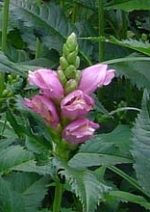 Also called red turtlehead and pink turtlehead, this rhizomatous herbaceous perennial is a member of the plantain family, Plantaginaceae, that also includes foxglove, snapdragon, and angelonia. It is endemic to the US and native to the Midwest and Southeast where it grows in wetlands and stream edges. Plants grow 2-3′ tall and form stiff clumps of many light green, smooth, hairless stems bearing broadly lanceolate leaves up to 8″ long and with coarsely serrated margins, and short petioles. The snapdragon-like flowers are 1.5 inches long, two lipped, and red, rose, or pink. They arguably resemble turtle heads and are carried in dense terminal racemes from late summer to fall with a very long bloom season. The showiest of the Chelones, rose turtlehead is a good choice for the edges of a water garden, swampy areas, shade or woodland garden, or a border where moisture is consistently available. The genus name Chelone is the Greek word for tortoise. The specific epithet, oblique, comes from the Latin word obliquus meaning lopsided.
Also called red turtlehead and pink turtlehead, this rhizomatous herbaceous perennial is a member of the plantain family, Plantaginaceae, that also includes foxglove, snapdragon, and angelonia. It is endemic to the US and native to the Midwest and Southeast where it grows in wetlands and stream edges. Plants grow 2-3′ tall and form stiff clumps of many light green, smooth, hairless stems bearing broadly lanceolate leaves up to 8″ long and with coarsely serrated margins, and short petioles. The snapdragon-like flowers are 1.5 inches long, two lipped, and red, rose, or pink. They arguably resemble turtle heads and are carried in dense terminal racemes from late summer to fall with a very long bloom season. The showiest of the Chelones, rose turtlehead is a good choice for the edges of a water garden, swampy areas, shade or woodland garden, or a border where moisture is consistently available. The genus name Chelone is the Greek word for tortoise. The specific epithet, oblique, comes from the Latin word obliquus meaning lopsided.
Type: Herbaceous perennial
Bloom: Snapdragon-like flowers 1.5″ long, two lipped, red, rose, pink, in dense terminal racemes from late summer to fall
Size: 2-3′ H x 2″ W
Light:Full sun to part shade
Soil:Fertile, consistently moist to wet
Hardiness: Zones 6-9
Care: Pinch in spring to reduce ultimate height
Pests and Diseases: None of significance but may develop mildew in dry soil
Propagation: Seed, division in early spring or fall, cuttings in spring and summer
Companion Plants: Anaphalis, aster, Anthemis, sedum, lobelia, Joe-Pye weed, Japanese anemone
Outstanding Selections:
‘Alba’ (white flowers)
‘Bethelii ‘(more floriferous, more intense rose color)